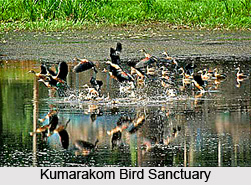 Vembanad Lake is the longest lake in India, and the largest brackish lake in the state of Kerala. Vembanad Lake is also counted as one of the largest lakes in India. Kottayam is a vast network of rivers and canals. These are empting into the great expanse of water called the Vembanad Lake. Vembanad Lake is an enchanting picnic spot and a fast developing backwater tourism destination. Vembanad Lake also provides boating, fishing and sightseeing experiences which are thrilling.
Vembanad Lake is the longest lake in India, and the largest brackish lake in the state of Kerala. Vembanad Lake is also counted as one of the largest lakes in India. Kottayam is a vast network of rivers and canals. These are empting into the great expanse of water called the Vembanad Lake. Vembanad Lake is an enchanting picnic spot and a fast developing backwater tourism destination. Vembanad Lake also provides boating, fishing and sightseeing experiences which are thrilling.
Thannermukkom Salt Water Barrier
Thannermukkom Salt Water Barrier was constructed as a part of the Kuttanad Development Scheme. This barrier was erected to prevent the tidal action and interruption of salt water into the Kuttanad low-lands across Vembanad Lake between Thannermukkom on south and Vechur on north. Thanneermukkom Bund better known as Thannermukkom Salt Water Barrier was constructed in 1974 and is functional since 1976. It is the largest mud regulator in India.
Kumarakom Bird Sanctuary
 A visit to this bird sanctuary, Kumarakom Bird Sanctuary gives an excitement and pleasure to the tourists who come to visit this lake. This bird sanctuary also set in the Kerala Backwaters is an ornithologist`s paradise and a preferred place of migratory birds. The main residents of this Kumarakom Bird Sanctuary are the waterfowl, cuckoo, owl, egret, heron, cormorant, moorhen, darter, Brahminy kite and the duck, as well as the migratory Siberian crane. Parrot, teal, lark, flycatcher, and other birds are seen here during their respective migratory seasons. Some of the migratory birds come from the Himalayas, and a few from far away Siberia, are also seen this region.
A visit to this bird sanctuary, Kumarakom Bird Sanctuary gives an excitement and pleasure to the tourists who come to visit this lake. This bird sanctuary also set in the Kerala Backwaters is an ornithologist`s paradise and a preferred place of migratory birds. The main residents of this Kumarakom Bird Sanctuary are the waterfowl, cuckoo, owl, egret, heron, cormorant, moorhen, darter, Brahminy kite and the duck, as well as the migratory Siberian crane. Parrot, teal, lark, flycatcher, and other birds are seen here during their respective migratory seasons. Some of the migratory birds come from the Himalayas, and a few from far away Siberia, are also seen this region.
Vembanad Lake Back waters
Punnamada Kayal forms a part of Vembanad Lake, located in Alappuzha District of Kerala. Every year during the Onam festival, Nehru Trophy boat Race is held here. It is the most exciting boat race in which Chundan Vallam, which is known as the snakeshaped long boats with an arching head and with a big number of rowers compete after tough practice. While on a contrary Ashtamudi lake is a large lake with an area of 1700 sq km, has 8 tentacles going into the lush green inland. Water is mineral-rich, so enhances the ecosystem where nearly a 100 varieties of fish live. Birds reside in this place as this place is very conducive.















